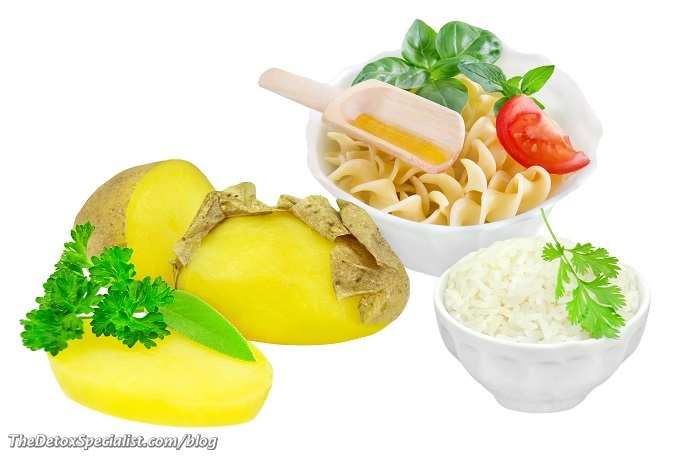
Questions about resistant starch foods seem to keep cropping up in some of the online health groups a lot recently. Resistant starch is appearing a lot in online blog articles too. What I don’t see anything about is how they can help with detoxing.
If you want to know more about resistant starch, resistant starch foods and how they can help with detoxing then read on. In addition, I will cover the health benefits of resistant starch foods.
As nutritional biochemist and researcher Jeff Bland states “Foods have long been recognized as key modulators of health. From Hippocrates to Ayurveda, the core idea is simple: foods and their constituents change our physiology and alter our wellbeing”.
It was Jeff who first got me interested in detox when he came to England some years ago for a weekend seminar that I attended. His lectures were always fascinating and full of thoroughly researched useful information.
What is Resistant Starch?
Resistant starch is a kind of fiber, but not all fibers are created equal. It is a type of starch that your body cannot digest. It is “resistant” to digestion and that is where it gets its name from. As such, it passes through your digestive system, just like other types of carbohydrates.
However, some of this resistant starch is fermented in the large intestine by “good” bacteria and converted into short-chain fatty acids (SCFAs). The main ones are acetate, butyrate and propionate.
SCFAs feed the good bacteria so they also act like a prebiotic. They are essential for the health of the digestive system and for the prevention of disease. Some are absorbed into the bloodstream and used as fuel by cells throughout the body.
There are technically 4 types of resistant starch. Here we are concerned with two of the main types:
Insoluble Resistant Starch
This starch is found in whole grains and legumes and resists digestion in the small intestine. It has many beneficial effects on health, including improved gut health, reduced appetite, and improved cholesterol levels.
Soluble Resistant Starch
This is found in cooked and cooled potatoes, bananas, and oatmeal. The insoluble form can become soluble when cooked or cooled at room temperature for several hours before eating.
To make it more complicated there can be several types of resistant starch in the same food. Also, remember that resistant starch foods are not the same as resistant starches. As mentioned, resistant starches (RS) occur naturally in some foods, and they can also be formed in other foods through processing or cooking methods like freezing or boiling in water.
How Do Resistant Starch Foods Help with Detoxing?
Prevent constipation
One way that resistant starch helps detox is by preventing constipation and promoting regular bowel movements. This is important because one way your liver gets rid of the toxins it processes is via bile which gets eliminated from your body in bowel movements.
When you’re constipated, toxins stay in your body longer than usual and have more time to be re-absorbed into your bloodstream. Bile is stored in the gallbladder which is triggered to contract and release it when you eat some fat in meal. That’s why it’s a mistake to have a low-fat diet. You need to be eating healthy fats for good health.
Related reading: Health Benefits of Chia Seeds for Detoxing the Gut
Resistant starch promotes regularity by bulking up waste in the colon so it moves out more quickly. This prevents straining during bowel movements, which causes pain and potential damage to the colon wall.
Supports beneficial gut bacteria
Various gut microbiota can metabolize environmental chemicals. This in effect is a way toxins get detoxified before they even get into your body. So, supporting the beneficial bacteria in the gut with the effects of resistant starch will help with detoxing.
Blood sugar regulation
Another way resistant starch and resistant starch foods helps detoxification is by regulating blood sugar levels. Resistant starch will not raise blood sugar levels like digestible carbohydrates. It may help lower insulin resistance and reduce insulin spikes that can cause inflammation throughout the body. Steady blood glucose levels means that the cells have the energy to carry out their detox function.
Studies have also shown that eating resistant starch can reduce fasting glucose levels and improve insulin sensitivity. This means resistant starches may help prevent diabetes or improve its symptoms if you already have it.
Reheated pasta
Your body breaks down the carbohydrate in pasta into sugar very quickly which can cause a rise in blood glucose. It’s an interesting fact that if you let cooked pasta cool down before reheating you will digest it like fibre instead of carbohydrate. This has the effect of reducing the rise in blood glucose by 50 percent.
I’m not advocating that you eat wheat pasta because gluten is hard on the digestive system. According to Dr Fasano, researcher into celiac disease, we don’t have the enzymes to fully digest modern wheat and that can be an issue for many people. And then there is the problem of the contamination by the toxic harbicide glyphosate which in turn has a detrimental effect on the gut microbiome.
Related reading: Going Gluten-Free: Will giving up Bread for Detox make you Fat?
Potato starch
Potato starch is one of the most concentrated sources of resistant starch, with about 80% of the starches in it being resistant It’s often used as a thickener or added to smoothies, yogurt or overnight oats. You only need 1–2 tablespoons per day. It’s important to not heat the potato starch. It’s best to add the starch to cold or cooled dishes. Be sure to get the starch and not potato flour which is not the same thing.
Here’s a recipe for a tasty Green Berry Smoothie which includes potato starch for you to try. You can of course ring the changes with other fruit such as bananas or mango. Also you can use other greens such as kale or a selection of baby green leaves. And, you can use MCT oil instead of coconut oil.
Resistant Starch Green Berry Smoothie
1/2 an organic lemon
1/2 cup frozen organic berries
1/2 organic apple, cored
1/2 cup organic parsley
1/2 ripe avocado or 3 tablespoons coconut oil
1 thumb size piece of fresh ginger, chopped
2 cups organic baby spinach
2 tbsp chia seeds or ground flax seeds
2 tbsp potato starch
2 cups almond milk or coconut water.
1 cup ice cubes (optional)
Put all ingredients into a high powered blender and whizz up until nice and smoothe. You might not want to add all the liquid to start with depending on how thick or thin you like your smoothie to be. If you like it on the thick side then start with enough liquid to allow the blades to turn easily. Then, add more liquid as you blend the mixture until you achieve the consistancy you prefer. Pour into your serving glass and sip slowly. Store any surplas in a covered contain in the fridge and use within 24 hours although the fresher the better.
What Are Some Examples of Resistant Starch Foods?
Here are some examples of RS foods:
- Legumes (beans, lentils, peas) – These are rich in resistant starch, protein, and fiber. Examples include kidney beans, chickpeas, and black beans.
- Starchy vegetables (potatoes, corn) – Depending on their preparation method, these contain varying amounts of resistant starch (boiled or microwavable produce has more resistant starch than baked or fried).
- Fruits with seeds (pumpkin seeds, plums) – The seeds in these fruits release a lot of resistant starch when cooked or soaked overnight.
- Oats – These contain more resistant starch than any other grain or cereal. And oatmeal is the most common way to consume oats, but you can also buy rolled oats (aka steel-cut oats) or quick oats for use in recipes such as overnight oats or granola bars.
- Cassava flour (tapioca) – Cassava flour has the highest amount of resistant starch out of all other flour flours at 10 grams per 100 grams! It’s best used as an ingredient in gluten free bread and baked goods rather than consumed alone due to its texture being similar to cornstarch.
What Are Some Other Benefits of Resistant Starch Foods?
Improved blood lipid profile: Consuming high amounts of resistant starches may improve blood lipids such as total cholesterol, LDL cholesterol, and triglycerides. This effect seems particularly strong in people with metabolic syndrome or type 2 diabetes who consume resistant starch.
Reduced risk of heart disease: Some studies have found that high-resistant starch diets protect against heart disease by lowering blood pressure. In addition, these diets may also lower levels of C-reactive protein – an inflammatory marker linked to cardiovascular disease risk.
Appetite control and weight management: Resistant starch can reduce appetite for several reasons. First, it helps increase satiety (feeling full). Second, it slows down digestion, so you feel full longer after eating. Lastly, resistant starch may also induce energy expenditure by increasing the number of calories burned after meals.
All in all, resistant starch is an excellent choice for anyone looking to improve their health and feel better. By enhancing your gut flora, resistant starches can help with everything from bloating to inflammatory issues to weight gain.
If you’re interested in getting some resistant starch foods into your diet look for organic potatoes as a great starting point or try out some other resistant foods above. Just remember that if you are not used to eating a lot of resistant starch foods then you may well get some mild side effects, such as gas and bloating.
The post Resistant Starch Foods: How They Help with Detoxing appeared first on The Detox Specialist.
-------------------------
By: Sandy Halliday
Title: Resistant Starch Foods: How They Help with Detoxing
Sourced From: thedetoxspecialist.com/blog/resistant-starch-foods-how-they-help-with-detoxing/
Published Date: Sat, 06 Aug 2022 12:45:28 +0000
Did you miss our previous article...
https://biohackersnews.com/detox/how-to-ensure-you-always-look-and-feel-your-best
.png)





